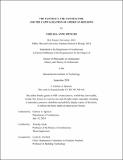The Contract, the Contractor, and the Capitalization of American Building
Author(s)
Spencer, Chelsea Anne
DownloadThesis PDF (140.4Mb)
Advisor
Hyde, Timothy
Terms of use
Metadata
Show full item recordAbstract
The heroic claims of twentieth-century architects notwithstanding, modern American architecture was built by general contractors. This new type of builder was unknown to US Americans before the Civil War, but by the turn of the twentieth century they commanded a powerful position in the widening gulf between architects and the construction of their buildings. Operating at the critical inflection point between projection and materialization, paper and concrete, contractors appealed to investment-minded clients as fellow businessmen, offering them what neither craft builders nor professional architects could deliver: a completed building, for a fixed price, on a guaranteed schedule.
This dissertation tells the story of how building became contracting in the United States during the long nineteenth century. Known to legal historians as the age of contract, the nineteenth century gave rise to a constellation of juridical and economic ideas that revolved around a vision of social relations modeled on market exchange and possessive individualism. Revealing the ideological and institutional foundations of today’s construction industry, the dissertation shows how nineteenth-century thinking about contract, freedom, value, and risk shaped the architectural building contract, the limits of the architecture profession, the practice of general contracting, and thus the modern relationship between architecture and building.
Date issued
2024-09Department
Massachusetts Institute of Technology. Department of ArchitecturePublisher
Massachusetts Institute of Technology